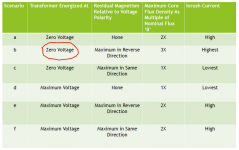Yes, correct. And what I was blabbering on about in post #33 is that, if the cards don't fall your way at the next switch-on, the core magnetism can get pushed beyond that "normal" amplitude you are referring to.
For example, if the residual magnetism is leftover near a positive peak (you can call that a "North Pole Direction" if you like the N-S compass pointings) AND you switch on at a zero crossing with the sine wave ready to build up more of the same North Pole strength - you drive the core into saturation for a few cycles. The core was already "sleeping" near a peak and you went and woke it up by pushing it more that same way.
It's all a crap shoot about when you turned it off and when you turned it on again.
I just looked quick on the interwebs and this site has a nice little chart at the bottom that breaks down the switch-on scenarios into 6 basic categories...
View attachment 2570483
I circled the second one - which describes the worst case scenario. Again, the whole point of my original post - and what always interested me the most - is that the worst case inrush can happen when you fire the thing back up from the zero crossing. Very counter-intuitive.


